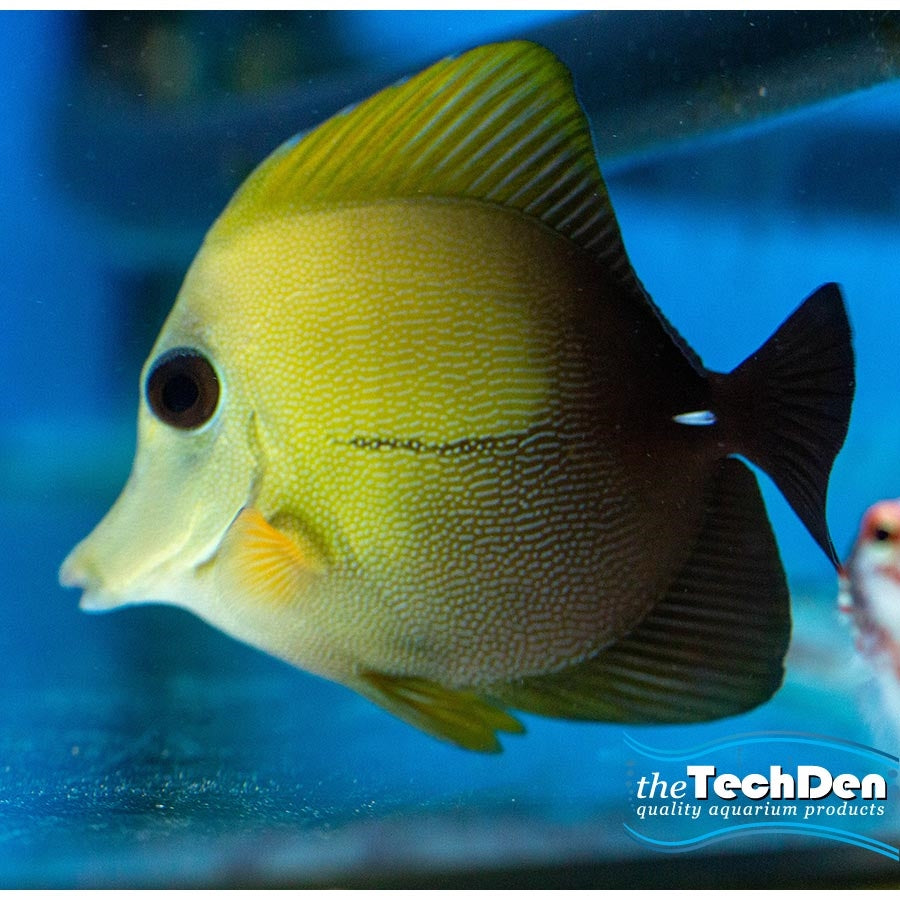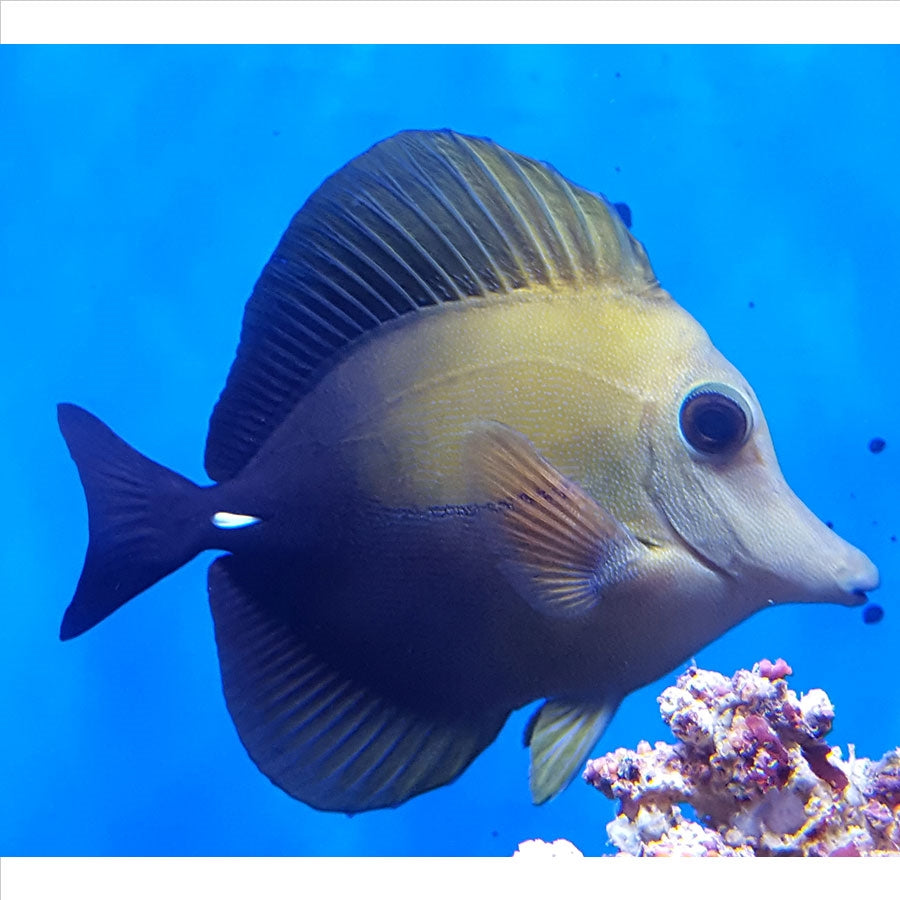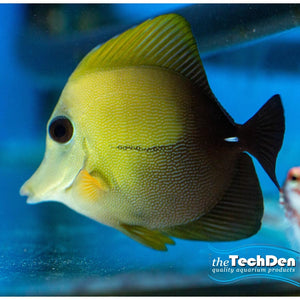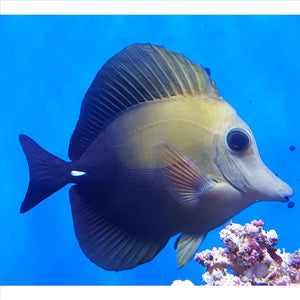The Scopas Tang (Zebrasoma scopas), also commonly known as the Brown Tang, Twotone Tang, or Sailfin Tang (though the true Sailfin Tang is Zebrasoma veliferum), is a popular and relatively hardy species of surgeonfish. It's known for its algae-grazing capabilities and distinctive coloration.
Here's a comprehensive care guide for the Scopas Tang:
Appearance:
-
Coloration: Scopas Tangs exhibit a range of colors, from an almost solid dark brown to a lighter yellowish-brown or even a mottled "koi" pattern with white blotches. The exact coloration can vary with mood and individual fish.
-
Body Shape: Like other Zebrasoma tangs, they have a distinctive disc-shaped, highly compressed body with an elongated snout, allowing them to graze effectively in crevices. They possess a sail-like dorsal fin that can be erected when threatened or displaying dominance.
-
Juvenile to Adult Changes: Juveniles often have a more mottled or striped pattern, which becomes less distinct or more uniform as they mature.
-
Caudal Spine: Possesses a single, retractable scalpel-like spine on each side of its caudal peduncle (tail base), used for defense. Males may have a patch of brush-like bristles before this spine, which is not present in females (sexual dimorphism).
Adult Size:
- The Scopas Tang typically reaches an adult size of 6 to 8 inches (15 to 20 cm) in captivity. While some sources suggest they can reach up to 12 inches (30 cm) or more, individuals rarely achieve this size in typical home aquariums.
Natural Habitat and Distribution:
- Found throughout the Indo-Pacific region, from East Africa to the Tuamoto Islands, north to southern Japan, and south to Lord Howe and Rapa islands (which includes waters around Australia, relevant for Caboolture).
- Inhabit coral-rich areas of lagoons and seaward reefs, typically grazing on various types of algae. Adults may form groups, while juveniles are often solitary, hiding among corals.
Aquarium Care (Easy to Moderate Level):
-
Minimum Tank Size: Due to their active swimming nature and adult size, a minimum of 75 gallons (approximately 284 liters) is recommended for a single Scopas Tang. However, a 100-120 gallon tank or larger is preferable to provide ample swimming room and reduce stress, especially in a community tank or if considering multiple tangs.
-
Water Parameters: Maintaining stable water quality is important.
-
Temperature: 74-80°F (23-27°C)
-
Salinity: 1.020-1.025 specific gravity
-
pH: 8.1-8.4
-
Alkalinity (dKH): 8-12 dKH
- Ammonia and nitrites must be 0 ppm. Nitrates should be kept below 20 ppm.
-
Filtration: A robust filtration system, including a good protein skimmer, is beneficial to handle their bio-load and maintain water quality.
-
Water Flow: Moderate to strong water flow is preferred. They are active swimmers and appreciate good circulation, which also helps keep algae circulating for grazing.
-
Diet:
-
Primarily Herbivorous: Like all tangs, their diet should be rich in marine-based algae and vegetable matter. They are excellent grazers on natural algae in the tank.
- Offer dried seaweed (nori) tied to a rock or using a veggie clip several times a week (at least 3-4 times, ideally daily).
- Supplement with high-quality herbivore pellets and flakes (e.g., Spirulina-rich foods), and other vegetable matter (e.g., blanched zucchini).
- They are technically omnivores and will accept meaty frozen foods like mysis shrimp or brine shrimp, but these should be offered sparingly as treats and not form the bulk of their diet.
- Frequent small feedings (2-3 times a day) are best to support their active metabolism and constant grazing. A well-fed tang is less prone to aggression and diseases like HLLE (Head and Lateral Line Erosion).
-
Temperament:
-
Semi-aggressive: Generally peaceful towards most non-tang tank mates.
-
Aggressive towards other tangs: They can be territorial and aggressive towards other tangs, particularly those of similar body shape (e.g., other Zebrasoma species like Yellow Tangs, Sailfin Tangs, Purple Tangs). It is generally recommended to keep only one Zebrasoma species per tank unless the tank is very large (180+ gallons) and they are introduced simultaneously or carefully.
- If kept in groups, they need an extremely large tank (300+ gallons) and all individuals should be added at the same time.
-
Reef Compatibility: Generally considered reef safe. They primarily graze on algae and are unlikely to bother corals or most invertebrates, making them a suitable addition to a mixed reef tank. They are excellent for natural algae control.
-
Tank Setup:
- Provide plenty of live rock with crevices and hiding places, as they enjoy exploring and resting among the rockwork.
- Ensure ample open swimming areas in the water column.
- A secure, tight-fitting lid is essential as they can jump when startled.
- A well-established aquarium with existing algae growth is beneficial for their initial feeding.
-
Disease Susceptibility: Like most tangs, they can be susceptible to marine ich (Cryptocaryon irritans) and other parasitic infections if stressed or in poor water quality. Maintaining pristine conditions and providing a varied, nutrient-rich diet (especially with garlic supplements) helps boost their immune system.
-
Acclimation: Proper and slow acclimation (drip acclimation) is essential.
-
Quarantine: Highly recommended to quarantine new arrivals for a few weeks to ensure they are healthy and eating well before introducing them to the main display.
![Eco Tech Advanced Reptile Thermostat - Dimming - Dual Electronic Thermostat.]()







